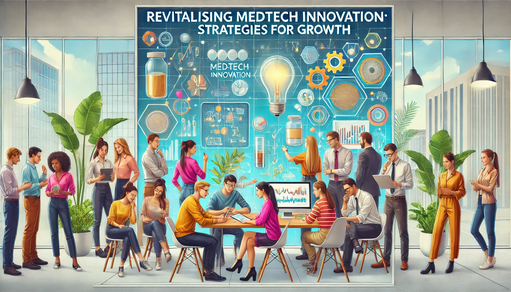- Many MedTech firms face stagnation, mounting debt, and innovation gaps in a rapidly evolving healthcare landscape
- Sustainable M&A requires a shift from short-term financial fixes to long-term, innovation-led strategies
- This Commentary presents a framework for systematically evaluating acquisitions against strategic and operational priorities
- Actionable steps are required for disciplined M&A, aligning investments with future healthcare demands
Disciplined M&A for MedTechs
Over the past four decades, the MedTech industry has transitioned from its early innovation-driven roots to a mature, consolidated landscape marked by growing complexity. Mergers and acquisitions (M&A), long celebrated as the engine of growth, have often resulted in unintended consequences: market oligopolies, diminished R&D productivity, and a slow response to emerging technologies reshaping healthcare delivery. Historically, the pursuit of acquisitions has frequently stretched executive teams and operational systems while increasing debt burdens - efforts that have sometimes failed to generate meaningful value. This pattern raises questions about the sustainability of traditional M&A strategies and underscores the need for a strategic overhaul. Today, many established underperforming MedTechs – dubbed the “have-nots” in a 2024 McKinsey report - find themselves tethered to legacy products, bureaucratic structures, risk-averse leadership, and incremental innovation. This inertia hinders their ability to adapt to fast-evolving market dynamics and the accelerating demands of modern healthcare.
The widespread reliance on debt financing has increasingly complicated the growth trajectories of many MedTech firms. While leveraging debt has historically fuelled expansion, this strategy often prioritises financial engineering over operational excellence and innovation. Debt burdens constrain strategic flexibility, especially during market disruptions or heightened regulatory scrutiny. Moreover, the elevated role of finance within corporate structures can shift priorities toward short-term profitability, diverting resources away from investments in R&D, advanced manufacturing, and sustainable quality systems. This overdependence on financial mechanisms and banking relationships tends to undermine the cultivation of robust collaborative ecosystems - dynamic networks of partnerships among industry players, academia, tech giants, start-ups, regulatory bodies, and supply chains - that are essential for fostering resilience, adaptability, and innovation. Consequently, companies become vulnerable to credit market fluctuations, which not only limit their financial agility but also impede their ability to prioritise patient outcomes and drive innovations, ultimately subordinating long-term value creation to short-term financial gains.
To regain momentum and achieve sustainable growth, MedTech firms must transition from reactive, acquisition-heavy strategies to proactive, innovation-led approaches. This transformation calls for the adoption of technologies, a focus on patient-centric solutions, the development of bold and adaptive leadership, and the alignment of R&D efforts to address critical, unmet healthcare needs. While M&A will remain a cornerstone of strategic growth, it must be reimagined within a disciplined, purpose-driven framework - prioritising acquisitions that strategically support long-term value creation and address the evolving demands of global healthcare. This forward-looking approach positions MedTech companies not just to survive but to lead in shaping the future of healthcare innovation.
In this Commentary
This Commentary provides a strategic roadmap for MedTech leaders, offering clear, actionable criteria for evaluating acquisitions and a simple, model for disciplined decision-making. It emphasises strategies that not only ensure acquisitions drive transformative innovation but also foster inclusivity and transparency, essential for eroding entrenched bureaucratic cultures. By adopting this approach, MedTech firms can shift their M&A strategies from reactive and incremental to proactive and transformative, positioning themselves as leaders in an evolving global healthcare landscape.
The Challenges Facing Traditional MedTech Companies
For decades, MedTech companies have relied heavily on debt financing to fuel growth through acquisitions, capitalising on the perceived stability of healthcare markets and historically low interest rates. While this strategy enabled short-term expansion, it has also left many firms burdened with debt, aging legacy portfolios, and an underinvestment in innovation. These financial and operational constraints have hindered their ability to adapt to shifting market dynamics and emerging technologies. Key challenges include:
- Stagnant Growth Underperforming MedTech companies frequently grapple with sluggish market growth, associated with a dependence on aging product portfolios. This reliance often curtails their capacity for innovation, erodes competitive differentiation, and narrows the pathways to revenue expansion or transformative market disruption.
- Erosion of Competitive Advantage Over-reliance on debt-financed acquisitions has diverted critical resources away from R&D, hindering innovation and leaving firms vulnerable to disruption by more agile, technology-driven competitors focused on dynamic market needs.
- Shifting Healthcare Priorities The rapid adoption of advanced technologies like artificial intelligence (AI), genomics, and IoT is transforming healthcare delivery. However, many under-resourced firms struggle to develop the capabilities or partnerships necessary to leverage these innovations effectively, risking reduced competitiveness in a rapidly evolving landscape.
- Valuation Pressures A McKinsey report (October 2024) emphasises that leading MedTech firms achieve success by outpacing industry growth, prioritising quality, fostering innovation, expanding profit margins, and ensuring strong cash flow. Investors are increasingly prioritising long-term value creation, scrutinising acquisitions for both their strategic alignment and financial returns. Companies that fail to demonstrate sustainable growth or achieve meaningful synergies risk declining valuations, emphasising the need for disciplined execution and a forward-thinking strategy in an increasingly competitive environment.
The Case for a Disciplined M&A Strategy
In today’s increasingly competitive and mature MedTech market, M&A must evolve beyond short-term financial engineering to prioritise sustainable, long-term value creation. To remain competitive and foster innovation, firms must adopt a disciplined approach to M&A that aligns with strategic objectives, strengthens operational capabilities, and addresses the evolving demands of healthcare. When guided by fundamental principles and a clear vision, M&A has the potential to drive transformative growth and position companies as leaders in the industry. Key principles include:
- Strategic Alignment Acquisitions must be carefully aligned with the company’s vision and long-term goals. This involves identifying opportunities that address critical capability gaps, expand geographic reach, or strengthen presence in high-growth market segments, ensuring the acquired assets contribute meaningfully to strategic priorities.
- Innovation-Centric Focus As technological advancements like AI, robotics, and personalised medicine reshape the healthcare landscape, successful acquisitions should prioritise enhancing technological and innovation capabilities. By fostering R&D growth and future-proofing product portfolios, companies can remain competitive and relevant in a rapidly evolving industry.
- Value Creation Acquirers must articulate and achieve measurable value creation. This includes identifying and delivering revenue synergies, operational efficiencies, and enhanced patient outcomes. A comprehensive post-acquisition integration plan is critical to realising these benefits, ensuring the financial rationale is translated into tangible, real-world outcomes. Such plans must prioritise sophisticated and detailed manufacturing processes, design issues, quality systems, and supply chains, recognising their role in driving sustained value and innovation.
- Cultural Compatibility Integration success depends on cultural alignment between the acquiring and target companies. Cultural misalignment can undermine collaboration and erode value, making an evaluation of organisational values, leadership styles, and operational approaches a critical component of the due diligence process.
Adopting a disciplined, strategic M&A framework enables MedTech companies to strengthen their competitive position, drive innovation, and deliver enduring value to stakeholders.
Criteria for Evaluating Potential Targets
To guide M&A decisions, MedTech leaders should evaluate potential targets against five key criteria:
Strategic Fit
Does the target company align with our long-term goals and core competencies?
Does it address unmet needs in high-growth or underserved markets?
Does it provide access to transformative technologies or new customer segments?
Innovation Potential
Does the target have a strong pipeline of innovative products or technologies?
Are there opportunities to integrate advanced technologies, such as AI, robotics, or digital health solutions, into our portfolio?
Does the target have access to dynamic ecosystems of innovation, such as academic research hubs and start-ups?
Financial Viability
Is the target financially stable, with manageable debt levels and healthy cash flows?
Are the acquisition costs reasonable, with clear potential for revenue synergies and operational efficiencies?
Does the target have a track record of sustainable growth and profitability?
Cultural Compatibility
Does the target company’s culture align with our own, promoting seamless integration and collaboration?
Are there shared values, such as a commitment to innovation, quality, diversity, and patient outcomes?
Are key leadership and talent retention risks manageable?
Regulatory and Market Risks
Are there regulatory or market barriers to the acquisition?
Does the target operate in regions with favourable reimbursement policies and healthcare systems?
Are there geopolitical or macroeconomic risks that could impact the acquisition’s success?
Optimising M&A Decisions
In the complex and high-stakes environment of MedTech M&A, a structured, inclusive, and transparent evaluation process is suggested for disciplined decision-making. A weighted average model offers a simple, practical, and scalable solution for assessing potential acquisitions. This assigns relative weights to key evaluation criteria - such as strategic alignment, innovation potential, financial impact, cultural fit, and integration feasibility - based on their importance to the organisation’s goals. Each target is then scored against these criteria, producing a composite score that serves as the foundation for decision-making.
A key advantage of this model lies in its flexibility and inclusivity, allowing for the engagement of a diverse range of board directors and senior executives across various functions, tailored to meet specific organisational needs. This fosters collaboration, ensures diverse perspectives are considered, and builds consensus. The resulting output often visualised using a traffic light system, provides an intuitive, actionable framework that simplifies the evaluation process and highlights opportunities with the greatest potential to create long-term value.
Step 1: Define Weights for Each Criterion
The first step in the model involves assigning relative weights to the evaluation criteria based on their strategic importance to the organisation. This process emphasises inclusivity and transparency by allowing input from directors and senior executives, ensuring diverse perspectives are reflected. The final weights are calculated as the average of all participants' inputs, fostering a sense of shared ownership and alignment.
For example, the following distribution might emerge:
- Strategic Fit: 30%
- Innovation Potential: 25%
- Financial Viability: 20%
- Cultural Compatibility: 15%
- Regulatory and Market Risks: 10%
This approach not only democratises the decision-making process but also ensures that each participant’s priorities are considered. By assigning collective weights, the model creates a transparent framework that highlights the organisation’s consensus on what matters most, making it easier to evaluate potential acquisitions against shared strategic goals.
Step 2: Score Potential Targets
The second step involves scoring each potential acquisition target on a standardised scale, typically from 1 to 10, for each evaluation criterion. Higher scores reflect stronger performance or alignment with the organisation’s strategic goals, providing a consistent and objective basis for comparison.
For example, a potential target might be scored as follows:
- Strategic Fit: 8
- Innovation Potential: 7
- Financial Viability: 6
- Cultural Compatibility: 5
- Regulatory and Market Risks: 9
This scoring process is designed to be inclusive, allowing directors and executives to contribute their evaluations. Individual scores are averaged to ensure that the final ratings reflect the collective perspective, promoting transparency and consensus. By involving a diverse group of stakeholders, this step ensures that scores account for a range of expertise and viewpoints, creating a robust and well-rounded assessment of each target’s strengths and weaknesses.
Step 3: Calculate Weighted Scores
Building on the weights defined in Step 1 and the scores determined in Step 2, the next step involves calculating the overall weighted score for each potential acquisition target. This is achieved by multiplying each criterion’s score by its corresponding weight and then summing the results. The weighted score provides a single, composite metric that reflects how well a target aligns with the organisation’s strategic priorities and performance benchmarks.
The formula for calculating the weighted score is:
Weighted Score = ∑ (Criterion Score × Weight)
Using the example weights and scores:
- Strategic Fit: 8 × 0.30 = 2.48 × 0.30 = 2.4
- Innovation Potential: 7 × 0.25 = 1.757 × 0.25 = 1.75
- Financial Viability: 6 × 0.20 = 1.26 × 0.20 = 1.2
- Cultural Compatibility: 5 × 0.15 = 0.755 × 0.15 = 0.75
- Regulatory and Market Risks: 9 × 0.10 = 0.99 × 0.10 = 0.9
The overall weighted score is:
Weighted Score = 2.4 + 1.75 + 1.2 + 0.75 + 0.9 = 7.1
This process links seamlessly with Step 1, where weights were collectively determined, and Step 2, where targets were scored collaboratively. By averaging inputs from directors and executives, the model ensures that the weighted scores embody an inclusive and transparent evaluation. The result offers a clear, data-driven metric to rank acquisition opportunities, guiding informed and consensus-driven decision-making.
Step 4: Interpret the Results
The final step translates the weighted scores into a simple and intuitive traffic light system, offering clear guidance for decision-making. This system ensures that results are easily understood by all stakeholders, and provides a sound basis for next steps.
- GREEN (7.5–10): High-potential target. These acquisitions strongly align with strategic goals, demonstrate clear synergies, and carry manageable risks. Proceed to detailed due diligence with confidence, focusing on integration planning to maximise value.
- AMBER (5.0–7.4): Moderate potential. These targets show promise but require careful evaluation of risks, synergies, and potential challenges. Additional scrutiny is needed to determine whether the opportunity aligns with long-term goals and justifies further investment.
- RED (0–4.9): Low potential. These acquisitions are unlikely to add meaningful value or align with strategic priorities. Unless extraordinary circumstances exist, they are not recommended for pursuit.
The traffic light system streamlines communication and emphasises accountability and actionability. Targets scoring in the green range warrant immediate attention, while those in amber demand further discussion and risk assessment. Red scores signal a clear decision to deprioritise or avoid the opportunity, ensuring resources are allocated efficiently.
This scoring framework, built on the inclusive and transparent processes of Steps 1–3, empowers decision-makers to act decisively and collaboratively, balancing rigour with simplicity in evaluating M&A opportunities.
Operationalising the Model
Effectively implementing the model requires a structured, collaborative, and adaptive approach. MedTech companies can operationalise the model by focusing on the following steps:
- Develop Clear Guidelines Establish standardised and well-defined evaluation criteria aligned with the company’s strategic goals. Ensure weighting schemes are flexible yet consistent, reflecting organisational priorities while allowing adjustments for unique acquisition contexts. Clear documentation ensures transparency and consistency across evaluations.
- Build Cross-Functional Teams Form evaluation teams that include representatives from key functions such as finance, R&D, operations, quality systems, and corporate development. This ensures a comprehensive assessment, capturing diverse perspectives and expertise to address both qualitative and quantitative dimensions of potential acquisitions.
- Leverage Data and Analytics Incorporate advanced analytics, AI, and market intelligence tools to evaluate potential targets. These technologies can identify patterns, trends, and risks that may not be immediately visible, providing deeper insights to strengthen decision-making.
- Ensure Board Alignment Engage board members early in the M&A process to agree on strategic priorities, evaluation criteria, and weightings. This proactive alignment reduces the risk of last-minute disagreements and ensures the board has a clear understanding of the decision-making framework.
- Monitor and Refine Regularly evaluate the model’s performance by analysing outcomes from completed acquisitions. Use insights to refine the evaluation criteria, weightings, and processes, ensuring the model evolves with the company’s strategy and the dynamic MedTech landscape.
By embedding these steps into the organisation’s M&A strategy, MedTech companies can foster a disciplined, data-driven, inclusive, and transparent approach, enabling them to capitalise on opportunities and drive sustainable growth.
Takeaways
For MedTech underperformers achieving sustainable growth requires a shift toward a disciplined, innovation-driven approach to M&A. By focusing on key factors such as strategic fit, innovation potential, financial viability, cultural compatibility, and regulatory awareness, leaders can make informed, value-enhancing acquisition decisions. These priorities not only improve valuations but also drive meaningful growth and deliver better patient outcomes. The model offers a simple, practical, transparent, and inclusive tool for evaluating acquisition opportunities, ensuring M&A strategies are rooted in rigorous analysis and aligned with long-term corporate goals.
In a rapidly evolving healthcare landscape, the MedTech companies poised for success will be those that transcend the debt-driven, short-term tactics of the past. The future belongs to organisations that prioritise transformative innovation and strategic partnerships, using M&A not as an end but to enhance capabilities, broaden market reach, and generate sustainable value. For visionary leaders willing to champion these shifts, the rewards extend beyond financial gains - encompassing the cultivation of inclusive, transparent organisational cultures and a significant, positive impact on patient outcomes worldwide. By adopting this approach, corporations can solidify their position as trailblazers in a highly competitive and dynamic industry.
|

























